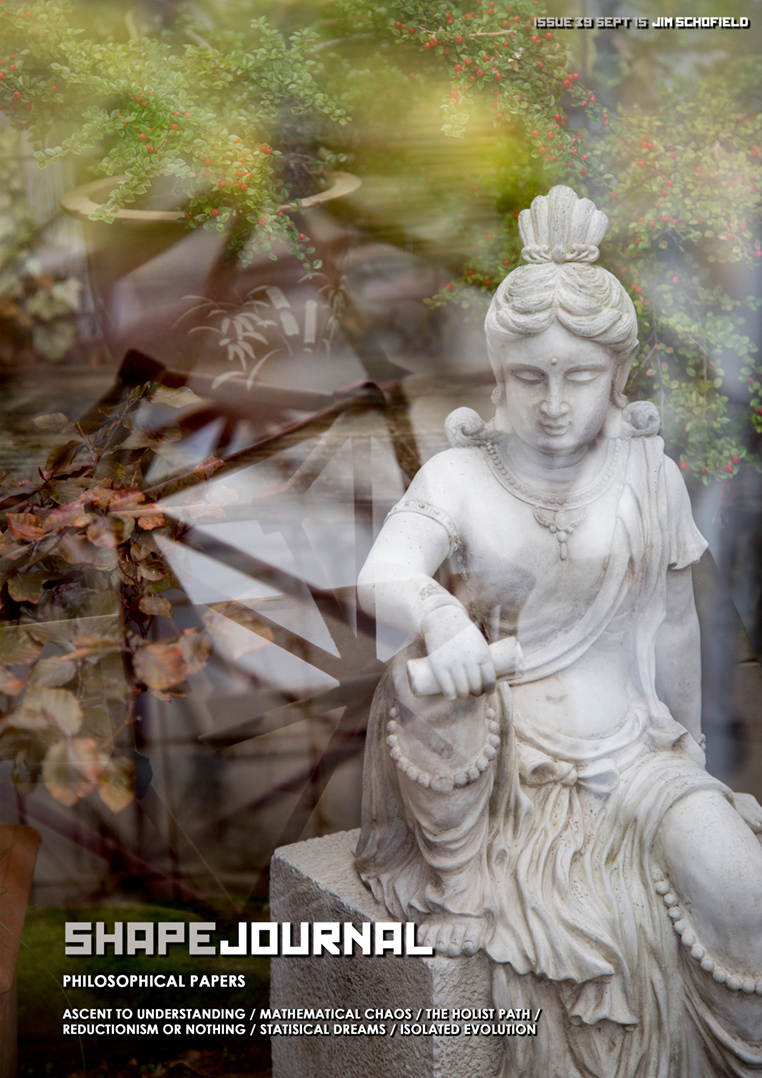Use before understanding!
IntroductionCurrently, Physics is seemingly embroiled in an irresolvable crisis, and to understand how it arrived at this desperate juncture, it is necessary to go back to its historical sources, and understand its initial and continuing motivations, and, even more importantly, its intellectual origins too.
From Man's hunter/gatherer origins he had effectively conquered the known World with his dexterity and intelligence, coupled with a single practical tenet, namely, "If it works, it is right", or, in a word - Pragmatism! Remarkably, with experience, intelligence and some basic arithmetic, Mankind had created Agriculture, Irrigation and even metal-working, and also, for its ever increasing trade, built roads, canals, and even sea-going ships, to supply their fast-growing cities.
Even Pyramids of colossal size, were constructed, as well as temples and palaces, and then giant empires were built across many countries. At a certain juncture in this trajectory, and focussed in the City States of Ancient Greece, Mankind began to create an intellectual aspect in its cultural life, going beyond, but still built upon, that same Pragmatism.
And the first developable intellectual discpline which was realised was Mathematics, or to bemore precise, that foundation stone of Mathematics, termed Geometry.
Observing both nature and his own works, Man discerned certain patterns, which recurred over and over again, and via "drawing" them in the sand, or on paper, he idealised them into Pure Forms, which could then be studied, as such!
Remarkably, these idealised extractions could, in themselves, be studied and indeed sequentially related to one another, so that a new, extended intellectual discipline was created of seemingly endless range and complexity.
It was a remarkable creation, for it certainly did not exist, as such, in Reality, but did, at least partially, reflect aspects of Reality, though ONLY in a descriptively formal and idealised way. And, crucially, it could also be used effectively, if approximately, to predict certain kinds of outcomes!
Such successes caused it to colour our thinking in general! It was the immutability of the ideal forms that seemed to enable the proliferation of both its processes and its regular extensions. So, when the same approach was applied to Reasoning - involing the implications of statements, it led to Formal Logic, as another seemingly infinitely extensible intellectual discipline. An idealised and manipulate-able parallel world, of useable reflections, had been shown to be possible, and began to grow at markable rate.
What had been involved, in these developments, was a brilliant extension of that process, which Mankind had been doing for millennia - a process which became known as
Abstraction.

It extracted something from Reality, which could be, thereafter, effectively be used in Thinking, even though no individual abstraction was ever a fully comprehensive account. What it did contain, however, was often extremely useful: for it invariably had a significant measure of what is termed Objective Content.
The consequences, when the very same methods were applied in the observation of Reality, were, therefore, pre-determined. Abstractions, once again, extracted something of value, but in the form of unchanging entities and their fixed inter-relations or Laws: what was extracted and used were seen as fixedobjects with eternal Natural Laws ONLY affecting them - and, in the usually fairly stable unchanging circumstances, these were real reflections, and could be used effectively.
Of course, to begin with, such naturally stable situations were limited to things like the Observation of the Heavens, but slowly, Mankind learned how to control or "farm" local domains of Reality, into simplified and artificially maintained, stable situations that could indeed be processed effectively.
Science too was therefore inevitably built upon the same foundations. Indeed, the most profound, but unstated common premise involved-throughout, was the now standard idea of unchanging essences, and this later became known as the Principle of Plurality!
Early MethodsNow, early science, could not penetrate Reality very deeply: indeed, most observations and even measurements were superficial: they could not analyse Reality, but took it as it presented itself, and at best, when it was varying, Man could find ways of holding it still, and so making dependable measurements of that.
So, apart from dimensions and maybe weight, no underlying causes could be revealed. Gradually, though, overall conceptions began to be imagined such as Temperature, Pressure and Energy, but these were not seen as properties of individual constituent parts, but of the complex thing as-a-whole. In other words, early Science was, generally, entirely of this overall nature. And, even when it began to be realised that there, indeed, were constituent units making up a whole, it still wasn't possible to measure all the individual parts, and sum their effects.
Only overall, resultant values were measurable.
Now, as better means of penetrating things more deeply became available, various methods of relating these overall measurables to the constituent parts were developed, as were means of relating what could be determined from constituent parts to things measured overall.
A parallel suite of techniques to indiviual part measurements was developed to relate the two. It took the general title of Statistics, along with a means of top-down interpretations were part of the system, termed Probabilities.
Now, this short excursion was necessary, as it was an alternative to the a more general method of analysis, involving layer-below-layer, increasingly-detailed analytic revelatons, until some ultimate fundamental causing entities were finally reached.
That approach, termed Reductionism, soon dominated, though it was never carried through completely: instead it was just conceptually-assumed, to underpin all partial investigations. And, the same approach took all found relations, as direct consequences of Laws at a lower level, and so on level-below-level, until at the bottommost, fundamental level, there would be the final eternal Natural Laws generating all of Reality via a hierarchy of consequent levels.
So, wherever possible, this would be implemented, at least partially, and when it wasn't, the reliable Statistics and Probabilities were resorted to instead!
The Final CrisisNow, though usually ignored as being merely due to current ignorance, there were many intractable anomalies in the results obtained, due to the various differing and even contradictory premises and philosophical stances, that had been adopted by different groups of scientists doing different things.
But, the consequent, overall amalgam survived by a division of the participants involved, into different specialisms, who did their bit, within their particular stances, and passed over their results to other specialists, to be used as they saw fit!
Addressing the Massive Conceptual Crisis in PhysicsNow, this admittedly cursory introduction has been necessary, in order to tackle the significant retreat adopted in Sub Atomic Physics in response to the perplexing discovery of the Quantum, on the one hand, and the increasingly unavoidable anomalies and contradictions on the other.
In fact, the most basic definitions seemed to be being totally undermined, as Particles seemed to, sometimes, act like Waves, while Waves, occasionally, appeared to behave like descrete Particles.
So, the tendency that depended upon, and trusted most, the embodiment of discovered relations into Formal Equations, knew that they, as always, would be able to mirror all phenomena in such Forms, and denounced Explanatory Physics, at least, at the Sub Atomic Level, as mere self-kid.
Reality was said to be determined by formal equations (Natural Laws), and they would be found in this area too.
So, the reason for this writer's preamble will now become clear!
Bohr and Heisenberg, along with many others, gradually achieved their formal claims, by using Probabilities and Wave Equations in a physically unjustifiable ways. There is a name for such tricks in Mathematics: it is termed a frig!
There was NO underlying physical explanation for what they achieved, but, the ancient and still existing "If it works, it is right!" justification was used to finally dispense with all explanations other than "Obeys this equation!"
The new stance was termed The Copenhagen Interpretation of Quantum Theory, and its increasingly-emerging clear inadequacies had to be papered-over with an increasing number of speculative inventions, and further abstract extensions in Pure Mathematics.
Now, some physicists still refused to submit, including Einstein, but neither side had the faintest idea what in physical theory itself, had been the problem.
For, the problem was most certainly the Pragmatism-driven amalgam of contradictory premises, upon which Classical Science, Formal Logic and even Mathematics had all been built.
But, the key pragmatic botch-up was certainly in Sub Atomic Physics, where Materialism, Idealism and Pragmatism had been patched together upon the same premise of Plurality, with "If it works, it is right!" Indeed, it could only exist by repeated separations into distinct "specialisms", with defined and limited spans - all created at the precise points where blatant contradictions became unavoidable. But, of course, they were avoidable - by setting fixed boundaries exactly where the anomalies presented themselves, and "agreeing to differ" with co-operating colleagues in adjacent specialisms.
Indeed, throughout the Industrial Revolution, and the rise of the consequent form of Capitalist Economics in the 19th Century, Science had merely become the "Richest Mine" of new discoveries for Technology's proliferating and
profitable applications. There were "sound financial reasons" for the necessary blinkers!
So, try as they might, the Classical lobby could not defeat the Copenhageners.
They were simply too philosophically ill-equipped to do anything about it. David Bohm, and later the neo-Bohmians, tried with their suggestion of an accompanying Pilot Wave to every elementary Particle, but nothing theoretically was achieved.
The problems went far deeper, and unless they were made clearly evident and tackled head-on, absolutely no progress would be made.
Yet, 200 years before, the German idealist philosopher, Friedrich Hegel, had, in his Thinking about Thought research, begun to tackle the iniquities of pluralist Formal Logic, based, initially, upon the Dichotomous Pairs of contradictory concepts that had, 2,300 years earlier, led the Greek, Zeno of Elea, to formulate his famous Paradoxes - based upon the alternatives of Continuity and Descreteness.
Hegel unearthed multiple Dichotomous Pairs, which always brought Formal Reasoning to a dead halt - to a logical impasse, which could never, rationally, be transcended, but were always pragmatically "got around" by suck-it-and-see try-outs of each alternative to see which allowed a transition to further reasoning beyond the impasse. Absolutely no explanation of why that worked was ever revealed: it was a purely pragmatic (if it works, it is right) get-around!
But, Hegel found a solution: he unearthed the differing premises of each of the Dichotomous Pairs, and by correcting what was amiss or inserting what was missing, he healed the wound and restored a continuing Logic, at that point at least!
He also, as a holist (the direct opposite of Plurality) opened up the Dichotomy into a range of possibilities, both ends of which could dominate in differing circumstances, and even flip from one to the other, dynamically, at crucial overall transitions in complex situations. He developed the Interpentration of Opposites method of seeing complex situations from BOTH opposite points of view, and so began to get some sort of grasp upon Qualitative Change, which Formal Logic could never deal with.
But, Hegel was an Idealist: all things considered were only objects of Thought, while most answers could only be found in concrete Reality - that is by materialist scientists!
This was realised among Hegel's followers - The Young Hegelians, including both Feuerbach and Karl Marx, and they switched over to becoming materialists, while retaining Hegel's brilliant discoveries termed Dialectics.
In fact, Marx began to construct what he termed Dialectical Materialism, to distinguish it from the so-called Mechanical Materialist mish-mash of the current scientists. His objective was to create a Union of Science and Philosophy upon his new stance.
But, in spite of his wonderful contributions in History, Politics and Economics, he didn't ever get around to that crucial central task. His Mathematical Manuscripts revealed his efforts to get to grips with the other side, but as a mathematician and physicist, myself, it is clear that he didn't manage it.
It was simply too much to ask of a single individual, no matter how dedicated he was.
So now, we have another slant upon the current Crisis in Physics, as well as a direction of necessary research, but as both Marx and Lenin proved, it would require investigators who were professional mathematicians and scientists, who had also been won to Marxism, and, crucially, fully understood its philosophy and methodology.
Now, when put like that, it seems the required investigator has to be myself, but, committing to doing it is much easier said than done, for though I called myself a Marxist when aged just 19, it has taken me over 50 years of high-level research in my primary professions, namely Mathematics, Physics and Computing, with a career finally ending up as a professor in a world class University, before I finally believed I could do it.
In fact, I have already developed a non-Copenhagen Theory for the Double Slit Experiments, produced a definition of a Universal Substrate that can poropagate Electromagnetic Radiation in quanta, and deliver both Electrical and Magnetic fields subtended around initiating charged objects. I have also explained quantized electron orbits within atoms, without resorting to the Copenhagen stance, and am currently tackling Quantum Entanglement!
The reason it took so long was that I didn't really understand Dialectical Materialism, until I was forced back into studying both Hegel and Marx by demanding research into the Analysis of creative Human Movement in Dance. Not only did that research reap valuable rewards in those studies, but helped myself and my co-researcher win A British Interactive Video Award for excellence.
So, finally, after a long and necessary justification, I can, at last, begin to address the only research that would be considered valid by the Copehagen opposition [for they are convinced that their philosophic stance is totally adequate, no matter what I say].
But, arriving at their frigged formulae via a totally antagonistic set of premises and explanations, may just do the trick!
To be continued in Part II...





























